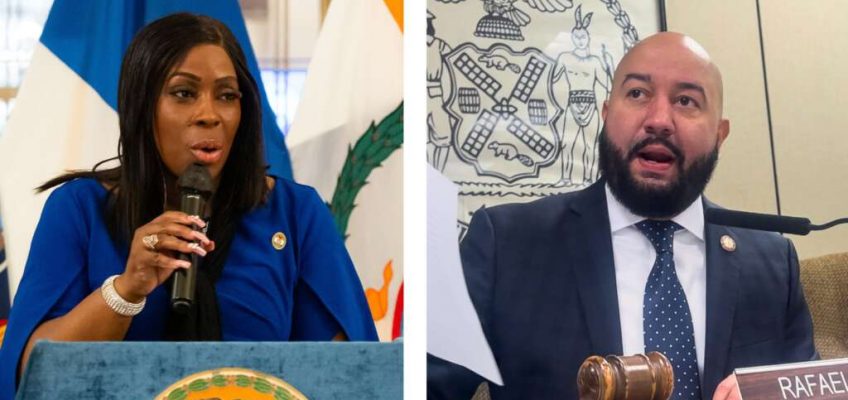Rafael Salamanca, currently a councilman and chair of the Council’s powerful Land Use Committee, is challenging the incumbent borough president, Vanessa Gibson. Several dynamics make this a race worth watching.
Current Borough President Vanessa Gibson, right. Her challenger, City Councilmember Rafael Salamanca, right. (Flickr/Office of the Bronx Borough President, William Alatriste/NYC Council Media Unit)
This analysis is part of a series exploring the role of the Latino vote in the city’s 2025 municipal elections. Read more about it here.
With all eyes on the race for the mayoralty, fewer New York City voters have yet glanced north to the Bronx, where a rumble of its own is shaping up. Rafael Salamanca, currently a councilman and chair of the Council’s powerful Land Use Committee, is challenging the incumbent borough president, Vanessa Gibson. Several dynamics make this a race worth watching.
Having won office four years ago, Gibson has one term left. Taking on an incumbent, who in this case is fairly well liked across the Bronx, does not happen often. But Salamanca has made the bold move, and might actually give Gibson a run for her money.
As a councilman with years of experience under his belt, Salamanca is no ordinary insurgent. Not only does he bring to the race the claim of city legislative experience (which Gibson has as well, from her previous Council experience and her current borough presidential role), he also comes to the race having raised a whopping $653,987, double the amount the incumbent Gibson has. At least in terms of fundraising, Salamanca clearly has not been hampered by the typical insurgent woes.
The chart above shows that Gibson has received over $184,557 more than Salamanca in public matching money. Yet Salamanca’s massive fundraising haul in private donations, and a lower spend up to this point in the campaign, has left him with a $300,000-plus spending advantage heading into the last six weeks of the race. At least when it comes to money, Salamanca has an edge.
But money isn’t everything, at least not in this race. Salamanca is taking on a well-liked incumbent in Gibson. She has the backing of the Bronx Democratic Party, the powerful union 1199, the Working Families Party, and numerous elected officials (many of whom are Latino) across the Bronx. For most insurgents, taking on an incumbent with this level of support usually spells trouble. Can Salamanca defy the odds?
He has certainly removed the usual fundraising advantage that most incumbents enjoy. But what about other factors? Does Salamanca have a path given that the Bronx is the only Latino-majority borough? According to the most recent voter file, Latinos comprise 46 percent of all registered Bronx Democrats. The next largest group, based on excellent data from the firm L2, is Black voters at 35 percent.
This may seem to suggest an advantage for Salamanca. However, things are a bit more complicated in the Bronx for anyone considering the Latino vote as an exclusive path to victory (this is not to say that this is Salamanca’s strategy). For one, the Latino vote alone is not enough to give any candidate the win. Moreover, Latino voting participation in the Bronx, as in other places, lags behind other groups.
Let’s take a look at numbers from the last municipal election in the Bronx in 2021, when Gibson was first elected as borough president.
Several elements are important to understand here. First, only 20 percent of eligible Bronx voters came out to the polls in the 2021 election. In Manhattan, 34 percent of eligible voters went to the polls. In Brooklyn, it was 29 percent. Similar rates applied in Queens and Staten Island. The Bronx is the borough with the lowest voting participation rates in the city—for reasons I won’t address here.
Moreover, not only is voting participation low borough-wide, it’s particularly low among Latinos. Only 15 percent of eligible Latino Democratic voters participated in the 2021 election. By comparison, 24 percent of eligible Black voters went to the polls, as did 29 percent of (the considerably fewer) eligible white voters.
When it comes to Latino voting participation the question remains: What is holding Latinos back from participating in elections? Unfortunately, many Latino elected officials in the borough are neglecting to engage the question.
All this notwithstanding, Salamanca will need to win the lion’s share of the Latino vote to make this a competitive race. If Gibson manages to pull enough Latinos to her column, which is not impossible for her to do, Salamanca will have a very long night on election day.
If this race comes down to voters making choices by fealty to race and ethnicity, my eyes will be glued to results in neighborhoods that are mostly non-Black and Latino. Almost half of these voters are in Riverdale, where a key Gibson supporter, Assemblyman Jeffrey Dinowitz, has his base.
Another 21 percent of these voters reside in Morris Park, City Island, and Pelham Bay, areas represented by another Gibson backer, Assemblyman Michael Benedetto. Both Dinowitz and Benedetto have long been party stalwarts, and their support for Gibson will be critical in this race. In addition to pulling out the Latino vote, Salamanca’s chances will depend on how many of these voters he’ll be able to convince.
Clearly much is at stake for both candidates. Gibson is the only incumbent borough president facing a serious challenge. And Salamanca aspires to be the fifth Latino borough president of the Condado de la Salsa. One thing is for sure: with fewer than six weeks to go, this rumble in the Bronx will become more contentious before it is over.
Eli Valentin is a former Gotham Gazette contributor and currently serves as assistant dean of graduate and leadership studies at Virginia Union University. He lives in New York with his family.
The post A New Rumble in the Bronx: Battle for the Borough Presidency appeared first on City Limits.


Leave a Reply